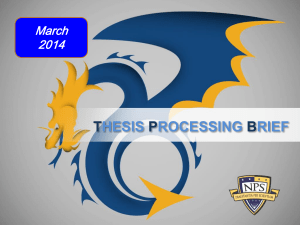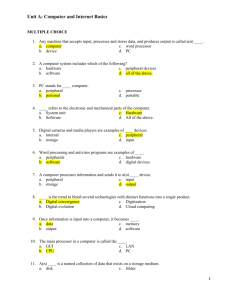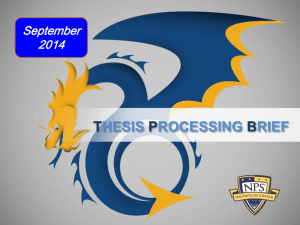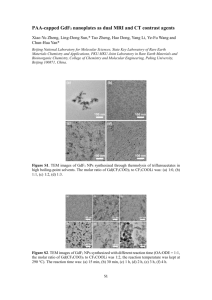Treshchalov JOINT-COST-Bertinoro-13-17-September
advertisement
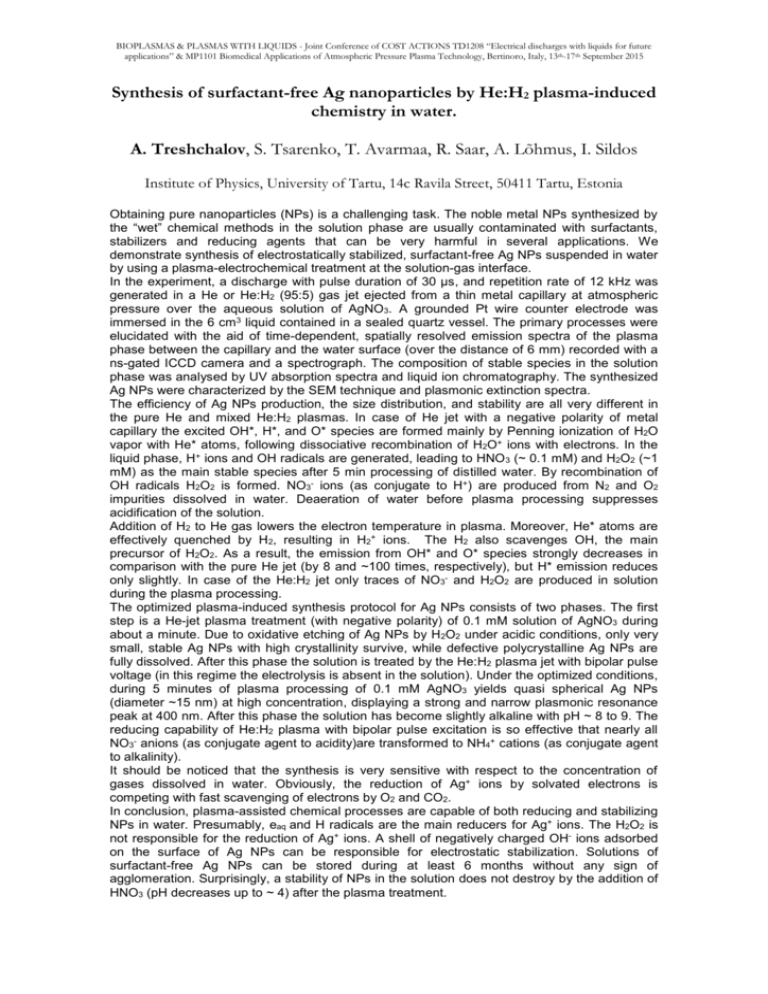
BIOPLASMAS & PLASMAS WITH LIQUIDS - Joint Conference of COST ACTIONS TD1208 “Electrical discharges with liquids for future applications” & MP1101 Biomedical Applications of Atmospheric Pressure Plasma Technology, Bertinoro, Italy, 13th-17th September 2015 Synthesis of surfactant-free Ag nanoparticles by He:H2 plasma-induced chemistry in water. A. Treshchalov, S. Tsarenko, T. Avarmaa, R. Saar, A. Lõhmus, I. Sildos Institute of Physics, University of Tartu, 14c Ravila Street, 50411 Tartu, Estonia Obtaining pure nanoparticles (NPs) is a challenging task. The noble metal NPs synthesized by the “wet” chemical methods in the solution phase are usually contaminated with surfactants, stabilizers and reducing agents that can be very harmful in several applications. We demonstrate synthesis of electrostatically stabilized, surfactant-free Ag NPs suspended in water by using a plasma-electrochemical treatment at the solution-gas interface. In the experiment, a discharge with pulse duration of 30 μs, and repetition rate of 12 kHz was generated in a He or He:H2 (95:5) gas jet ejected from a thin metal capillary at atmospheric pressure over the aqueous solution of AgNO3. A grounded Pt wire counter electrode was immersed in the 6 cm3 liquid contained in a sealed quartz vessel. The primary processes were elucidated with the aid of time-dependent, spatially resolved emission spectra of the plasma phase between the capillary and the water surface (over the distance of 6 mm) recorded with a ns-gated ICCD camera and a spectrograph. The composition of stable species in the solution phase was analysed by UV absorption spectra and liquid ion chromatography. The synthesized Ag NPs were characterized by the SEM technique and plasmonic extinction spectra. The efficiency of Ag NPs production, the size distribution, and stability are all very different in the pure He and mixed He:H2 plasmas. In case of He jet with a negative polarity of metal capillary the excited OH*, H*, and O* species are formed mainly by Penning ionization of H2O vapor with He* atoms, following dissociative recombination of H2O+ ions with electrons. In the liquid phase, H+ ions and OH radicals are generated, leading to HNO 3 (~ 0.1 mM) and H2O2 (~1 mM) as the main stable species after 5 min processing of distilled water. By recombination of OH radicals H2O2 is formed. NO3- ions (as conjugate to H+) are produced from N2 and O2 impurities dissolved in water. Deaeration of water before plasma processing suppresses acidification of the solution. Addition of H2 to He gas lowers the electron temperature in plasma. Moreover, He* atoms are effectively quenched by H2, resulting in H2+ ions. The H2 also scavenges OH, the main precursor of H2O2. As a result, the emission from OH* and O* species strongly decreases in comparison with the pure He jet (by 8 and ~100 times, respectively), but H* emission reduces only slightly. In case of the He:H2 jet only traces of NO3- and H2O2 are produced in solution during the plasma processing. The optimized plasma-induced synthesis protocol for Ag NPs consists of two phases. The first step is a He-jet plasma treatment (with negative polarity) of 0.1 mM solution of AgNO3 during about a minute. Due to oxidative etching of Ag NPs by H 2O2 under acidic conditions, only very small, stable Ag NPs with high crystallinity survive, while defective polycrystalline Ag NPs are fully dissolved. After this phase the solution is treated by the He:H2 plasma jet with bipolar pulse voltage (in this regime the electrolysis is absent in the solution). Under the optimized conditions, during 5 minutes of plasma processing of 0.1 mM AgNO3 yields quasi spherical Ag NPs (diameter ~15 nm) at high concentration, displaying a strong and narrow plasmonic resonance peak at 400 nm. After this phase the solution has become slightly alkaline with pH ~ 8 to 9. The reducing capability of He:H2 plasma with bipolar pulse excitation is so effective that nearly all NO3- anions (as conjugate agent to acidity)are transformed to NH4+ cations (as conjugate agent to alkalinity). It should be noticed that the synthesis is very sensitive with respect to the concentration of gases dissolved in water. Obviously, the reduction of Ag+ ions by solvated electrons is competing with fast scavenging of electrons by O2 and CO2. In conclusion, plasma-assisted chemical processes are capable of both reducing and stabilizing NPs in water. Presumably, eaq and H radicals are the main reducers for Ag+ ions. The H2O2 is not responsible for the reduction of Ag+ ions. A shell of negatively charged OH- ions adsorbed on the surface of Ag NPs can be responsible for electrostatic stabilization. Solutions of surfactant-free Ag NPs can be stored during at least 6 months without any sign of agglomeration. Surprisingly, a stability of NPs in the solution does not destroy by the addition of HNO3 (pH decreases up to ~ 4) after the plasma treatment.



